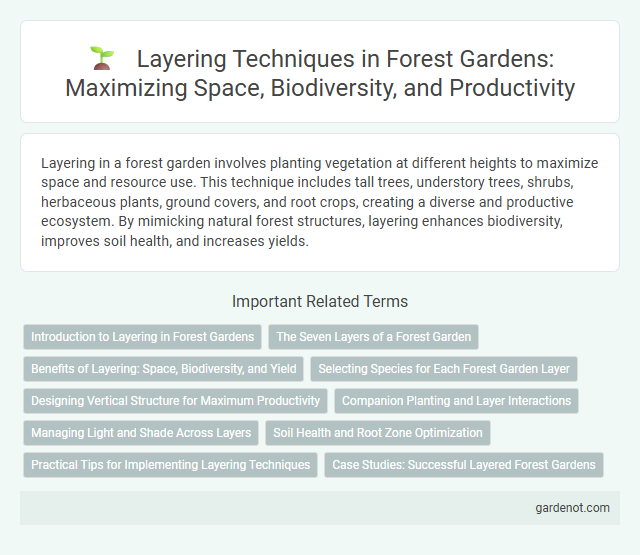Layering in a forest garden involves planting vegetation at different heights to maximize space and resource use. This technique includes tall trees, understory trees, shrubs, herbaceous plants, ground covers, and root crops, creating a diverse and productive ecosystem. By mimicking natural forest structures, layering enhances biodiversity, improves soil health, and increases yields.
Introduction to Layering in Forest Gardens
Layering in forest gardens mimics natural forest structures by organizing plants into vertical strata such as canopy, understory, shrub, herbaceous, ground cover, root, and vine layers. This method maximizes space efficiency, enhances biodiversity, and promotes sustainable food production by utilizing different growth habits and resource needs. Each layer supports the others through nutrient cycling, microclimate regulation, and pest control, creating a resilient ecosystem.
The Seven Layers of a Forest Garden
The Seven Layers of a forest garden include the canopy, understory, shrub layer, herbaceous layer, ground cover, root layer, and vertical layer, each playing a vital role in ecosystem diversity and productivity. The canopy consists of tall fruit and nut trees that provide shade and habitat, while the understory features smaller fruit trees and shade-tolerant plants. Ground covers and root layers help prevent soil erosion and enhance nutrient cycling, creating a self-sustaining agricultural system.
Benefits of Layering: Space, Biodiversity, and Yield
Layering in a forest garden maximizes vertical space, allowing diverse plants to thrive at different heights, which increases overall biodiversity and resilience. This structural complexity supports varied wildlife and beneficial insects, enhancing ecosystem health and pest control. Improved spatial efficiency through layering also boosts total yield by combining multiple productive species in a single area.
Selecting Species for Each Forest Garden Layer
Selecting species for each forest garden layer involves matching plants to their ideal vertical and spatial niches to maximize productivity and ecosystem health. Canopy trees like walnut or chestnut provide shade and nuts, while understory fruit trees such as apple or plum thrive beneath them. Ground covers, herbs, and root vegetables complete lower layers by improving soil fertility and deterring pests, creating a diverse and sustainable forest garden ecosystem.
Designing Vertical Structure for Maximum Productivity
Layering in forest garden design maximizes productivity by organizing plants into vertical strata, including canopy trees, understory trees, shrubs, herbaceous plants, ground covers, and root crops. Each layer harnesses available sunlight efficiently, promoting biodiversity and reducing weed growth. Strategic selection of species for each stratum enhances nutrient cycling and yields a resilient, self-sustaining ecosystem.
Companion Planting and Layer Interactions
Companion planting in forest gardens enhances layering by strategically combining plant species that support each other's growth, nutrient uptake, and pest resistance across vertical strata. Interactions between layers--canopy trees, understory shrubs, herbaceous plants, ground covers, and root crops--create microclimates and improve biodiversity, maximizing resource use efficiency. This symbiotic layering fosters healthy soil ecosystems, reduces competition, and increases overall productivity in sustainable agroforestry systems.
Managing Light and Shade Across Layers
Forest garden layering involves strategically managing light and shade to optimize plant growth and biodiversity, with tall canopy trees capturing most sunlight while understory shrubs and groundcovers thrive in filtered light. Each layer, from emergent trees to low groundcovers, plays a specific role in maximizing photosynthesis and reducing energy waste through natural shade regulation. Effective layering balances light distribution, enhancing microclimates and promoting sustainable ecosystem health.
Soil Health and Root Zone Optimization
Layering in forest gardens enhances soil health by promoting diverse root systems that improve nutrient cycling and organic matter decomposition. Deep-rooted plants access subsoil nutrients while shallow-rooted species stabilize the topsoil, optimizing the entire root zone for water retention and aeration. This synergy strengthens microbial activity and supports resilient soil structure, crucial for sustainable forest garden productivity.
Practical Tips for Implementing Layering Techniques
Layering in forest gardening involves strategically planting multiple crop layers such as tall trees, shrubs, herbs, groundcovers, and root crops to maximize space and biodiversity. Practical tips include selecting plants with complementary growth habits and nutrient needs, ensuring proper spacing to avoid competition, and using nitrogen-fixing species to enrich soil fertility. Regular monitoring and adaptive pruning help maintain light distribution and promote healthy growth across all layers.
Case Studies: Successful Layered Forest Gardens
Successful layered forest gardens, such as Martin Crawford's Agroforestry Research Trust in the UK, demonstrate how integrating diverse plant layers--canopy, understory, shrub, herbaceous, ground cover, root, and climber--maximizes productivity and biodiversity. The key to their success lies in selecting complementary species that optimize sunlight, nutrient cycling, and space utilization within each vertical layer. Case studies reveal that layered planting reduces pest outbreaks and improves soil health, creating resilient and sustainable ecosystems.
Layering Infographic

 gardenot.com
gardenot.com